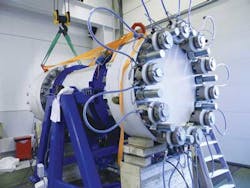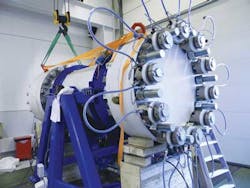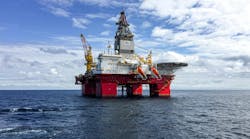View Article as Single page
Compared with conventional offshore topsides transformers, switchgear and VSDs, the design focus for the SPG has been on pressure-compensated technology with 100% natural cooling. This means the modules are fluid-filled and most of the components operate under full pressure. The fluid-filled and pressure-compensated design provides several advantages in terms of enhanced reliability, Siemens claims, including:
- Efficient natural cooling without any moving parts
- No differential pressure on penetrations to seawater, hence a reduced risk of leakage
- Very stable and safe environment for all components
- Same design applies to all water depths
- Enhanced insulation levels.
"All the equipment is being qualified according to the requirements from our JIP partners," Rasch explained. "We have been running a comprehensive qualification program according to customer expectations and recommended practice from DNV. This started by qualifying the technology from a component level before moving on to subassemblies, and concluding with a shallow-water test of the complete Subsea Power Grid. The program also includes endurance testing of all components using techniques that apply increased stress on the components to speed up testing to demonstrate a 30-year lifespan.
Test schedule
All tests on the subsea transformer were completed successfully in 2012 in the Trondheim pressure laboratory as well as in Trondheim harbor (shallow-water test), with results confirming that this is a market-ready product suitable for a wide power range (typically from 1 to 100 MVA) and for operation in water depths of down to 3,000 m (9,842 ft), says Siemens. Features of the transformer include an enhanced insulation system; a robust enclosure design with optimized natural cooling properties; biodegradable MIDEL 7131 fluid filling; flexible interfaces (dry or wet-mate conditions); and advanced condition monitoring (oil properties, temperature, pressure, ground fault, and so on).
The subsea switchgear has a modular design, featuring 36-kV, 500-A feeders and vacuum circuit-breakers; an integrated auxiliary supply; main switch in 1-atmosphere system canister; a fluid-filled base module; a pressure-compensated bus bar base section; a industrially proven SIPROTEC protection system; and zero differential pressure at all penetrations to seawater. The design is cascadable to allow more consumers to be configured, via connections to seabed templates.
Finally, the variable-frequency drives (VSDs) are also of a modular and pressure-compensated design said to achieve 100% natural convection cooling via dielectric fluid. Internal temperature variations cause fluid to flow, generating the cooling effect.
The VSD prototype will be completed and qualified next year prior to the fully integrated shallow-water trials. "This is probably the most challenging of the three power units to qualify for operation in 3,000 m water depth," Rasch added. "It incorporates a scalable, multi-cell topology, meaning that it comprises many smaller 'building blocks,' or power cells. The number of building blocks is determined by the voltage rating of the unit. Redundancy can be built into the design by including more power cells than needed for the specified rating. If a power cell should fail, the advanced cell bypass function would bypass the power cell (i.e. remove it from the VSD power circuit), allowing the VSD to run with the remaining cells."
Rasch noted that there are other advantages in the multi-cell design with respect to harmonics. "A basic property of frequency converters is that they change the voltage in discrete steps. The output voltage consists of contributions from each of the power cells, and with a large number of cells, the total voltage can be changed in many discrete steps. By incorporating many small discrete steps in the output voltage waveform, we can achieve an almost sinusoidal output voltage with a low harmonic content. Furthermore, the number of cells, combined with a uniquely designed input transformer, cancels out most of the critical harmonic feedback to the supply – the result is low harmonics both to the motor and to the supplying grid."
Following the completion of pressure testing of the various components and subassemblies in the Trondheim lab (around the turn of this year), next year's planned test and qualification procedure is as follows:
- Module testing in a dry environment in assembly factory in Trondheim
- System integration and functional testing in assembly factory
- Shallow-water test and qualification of the switchgear prototype (currently being assembled in Trondheim, testing/qualification in 2015) and the VSD prototype (assembly and testing/qualification in 2015 in Trondheim)
- Shallow-water test and qualification of the power communications and control system
- Shallow-water test and qualification of the completed subsea power grid, including switchgear, VSD, transformer, and respective connections.






